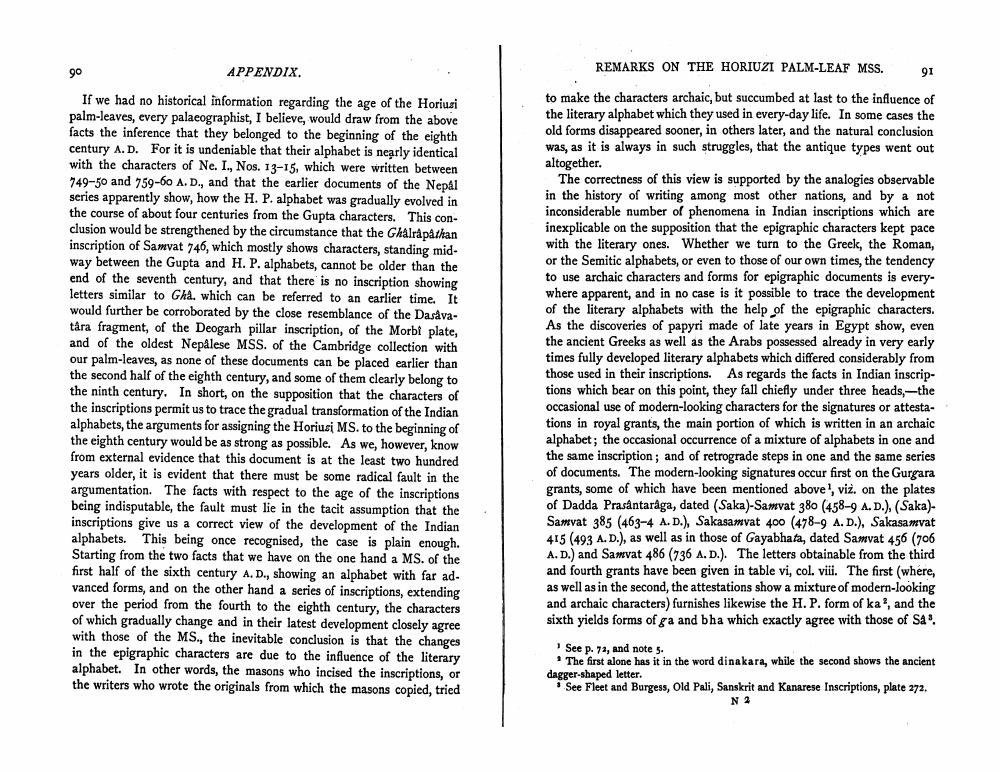________________
90
If we had no historical information regarding the age of the Horiusi palm-leaves, every palaeographist, I believe, would draw from the above facts the inference that they belonged to the beginning of the eighth century A. D. For it is undeniable that their alphabet is nearly identical with the characters of Ne. I., Nos. 13-15, which were written between 749-50 and 759-60 A. D., and that the earlier documents of the Nepál series apparently show, how the H. P. alphabet was gradually evolved in the course of about four centuries from the Gupta characters. This conclusion would be strengthened by the circumstance that the Ghalrapathan inscription of Samvat 746, which mostly shows characters, standing midway between the Gupta and H. P. alphabets, cannot be older than the end of the seventh century, and that there is no inscription showing letters similar to Gha. which can be referred to an earlier time. It would further be corroborated by the close resemblance of the Dasâvatåra fragment, of the Deogarh pillar inscription, of the Morbi plate, and of the oldest Nepâlese MSS. of the Cambridge collection with our palm-leaves, as none of these documents can be placed earlier than the second half of the eighth century, and some of them clearly belong to the ninth century. In short, on the supposition that the characters of the inscriptions permit us to trace the gradual transformation of the Indian alphabets, the arguments for assigning the Horiusi MS. to the beginning of the eighth century would be as strong as possible. As we, however, know from external evidence that this document is at the least two hundred years older, it is evident that there must be some radical fault in the argumentation. The facts with respect to the age of the inscriptions being indisputable, the fault must lie in the tacit assumption that the inscriptions give us a correct view of the development of the Indian alphabets. This being once recognised, the case is plain enough. Starting from the two facts that we have on the one hand a MS. of the first half of the sixth century A. D., showing an alphabet with far advanced forms, and on the other hand a series of inscriptions, extending over the period from the fourth to the eighth century, the characters of which gradually change and in their latest development closely agree with those of the MS., the inevitable conclusion is that the changes in the epigraphic characters are due to the influence of the literary alphabet. In other words, the masons who incised the inscriptions, or the writers who wrote the originals from which the masons copied, tried
APPENDIX.
REMARKS ON THE HORIUZI PALM-LEAF MSS.
91
to make the characters archaic, but succumbed at last to the influence of the literary alphabet which they used in every-day life. In some cases the old forms disappeared sooner, in others later, and the natural conclusion was, as it is always in such struggles, that the antique types went out altogether.
The correctness of this view is supported by the analogies observable in the history of writing among most other nations, and by a not inconsiderable number of phenomena in Indian inscriptions which are inexplicable on the supposition that the epigraphic characters kept pace with the literary ones. Whether we turn to the Greek, the Roman, or the Semitic alphabets, or even to those of our own times, the tendency to use archaic characters and forms for epigraphic documents is everywhere apparent, and in no case is it possible to trace the development of the literary alphabets with the help of the epigraphic characters. As the discoveries of papyri made of late years in Egypt show, even the ancient Greeks as well as the Arabs possessed already in very early times fully developed literary alphabets which differed considerably from those used in their inscriptions. As regards the facts in Indian inscriptions which bear on this point, they fall chiefly under three heads,-the occasional use of modern-looking characters for the signatures or attestations in royal grants, the main portion of which is written in an archaic alphabet; the occasional occurrence of a mixture of alphabets in one and the same inscription; and of retrograde steps in one and the same series of documents. The modern-looking signatures occur first on the Gurgara grants, some of which have been mentioned above1, viż. on the plates of Dadda Prasantaråga, dated (Saka)-Samvat 380 (458-9 A.D.), (Saka)Samvat 385 (463-4 A. D.), Sakasamvat 400 (478-9 A. D.), Sakasamvat 415 (493 A.D.), as well as in those of Gayabhata, dated Samvat 456 (706 A. D.) and Samvat 486 (736 A. D.). The letters obtainable from the third and fourth grants have been given in table vi, col. viii. The first (where, as well as in the second, the attestations show a mixture of modern-looking and archaic characters) furnishes likewise the H. P. form of ka3, and the sixth yields forms of ga and bha which exactly agree with those of Så3.
See p. 72, and note 5.
The first alone has it in the word dinakara, while the second shows the ancient dagger-shaped letter.
* See Fleet and Burgess, Old Pali, Sanskrit and Kanarese Inscriptions, plate 272.
N 2




